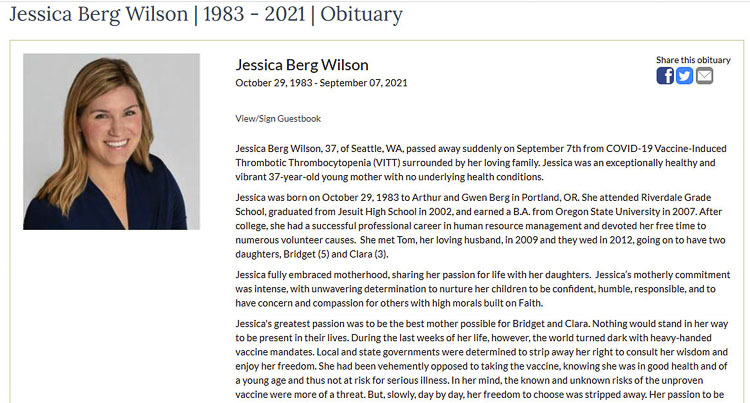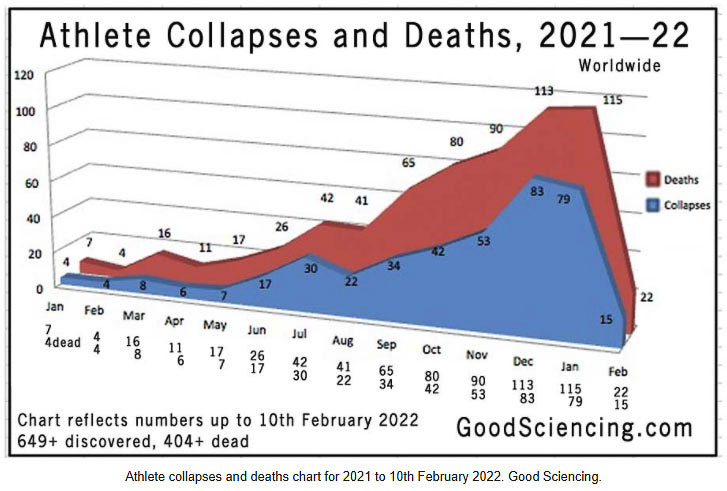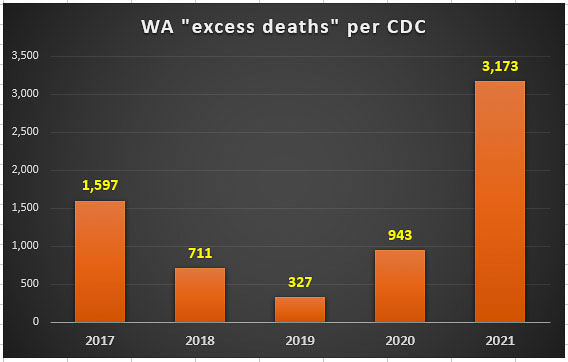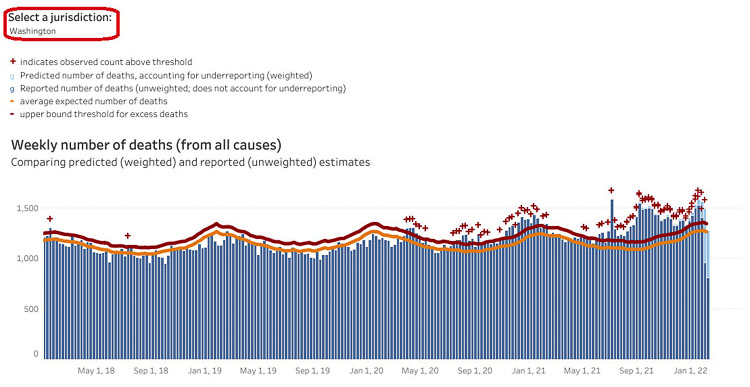How many people have been harmed by mandates or vaccines?
In the past few months, a couple of concerning stories have emerged. Young, healthy people have suddenly died. Sarah Ann Mikesell, a 36-year-old graduate of Woodinville High School died suddenly at her apartment in Seattle according to an obituary. Jessica Berg Wilson died at age 37 last September. Clark County Today also reported on a 17-year-old female who died from a heart attack, one of three deaths in the state attributed to the vaccine.
An informal review of local obituaries found 38 individuals from Clark County under the age of 60 who had died in the first six weeks of this year. Four were in their 20’s, seven in their 30’s and 10 were in their 40’s. The final 17 were in their 50’s.
Against this backdrop, many citizens have expressed concerns about possible adverse effects caused by the vaccines. After all, these were new technologies, especially for the mRNA delivery system that targeted the spike protein. The viral vector, single shot Johnson & Johnson vaccine had been “paused” early on. It was approved and then again “paused” for injection. News reports indicate Johnson & Johnson recently ceased production.
Blood clots, myocarditis, pericarditis, and heart conditions began surfacing as more people were vaccinated. Stories of extremely healthy athletes suddenly collapsing or even dying appeared. Then there were stories of average citizens dying, like Mikesell and others.
Then there were delays in getting care. Two separate times surgeries and hospital admissions have been stopped or limited by executive orders from Gov. Jay Inslee. How many people got sicker or possibly died because of these delays in seeking medical care?

The head of the Washington State Hospital Association, Cassie Sauer, says there is now a backlog of people waiting for surgery, following the most recent Inslee order. She also clarified that any medical centers that were not overloaded were able to perform less urgent procedures during the pause.
Since Feb. 1, 2020, the Centers for Disease Control and Prevention (CDC) estimate there have been 942,431 excess deaths in the U.S. One insurance company executive estimated that death rates are currently up 40 percent over what they were pre-pandemic. The insurance industry experienced the largest year-over-year increase in payouts since the 1918 influenza pandemic.
Separately, two executive orders by Gov. Jay Inslee kept people from getting what Inslee deemed as “elective” surgeries. Thousands of Washingtonians had medical procedures delayed. These range from colonoscopies to cancer care – anything that, if postponed, was not anticipated to cause harm to a patient within 90 days according to a recent emergency order.
In Washington, there were 3,173 “excess deaths” in 2021 according to the CDC data. That compares with 1,597 in 2017, 711 in 2018, 327 in 2019, and 943 in 2020. The Department of Health shows annual deaths from all causes were running about 54,000 per year in 2015 and 2016. They increased to 58,292 in 2019 and jumped to 63,173 in 2020, an 8 percent increase the first year of the pandemic.
The CDC explains that excess deaths are associated with COVID-19 directly or indirectly, typically defined as the difference between the observed number of deaths in specific time periods and the expected number of deaths in the same time periods.
Over the past year, there have been numerous stories of athletes suddenly collapsing on sports fields or during athletic competition. While the majority appear to be male, it has happened to females as well.
A new website has been documenting unexpected injuries or deaths, possibly linked to the COVID-19 vaccines. Goodsciencing.com is presently showing 649 athlete cardiac arrests, and 404 deaths following vaccination. The website describes Goodscience as:
“We are a small team of investigators, news editors, journalists, and truth seekers, now backed up by others, who are discovering pieces of information that we can investigate. It doesn’t really matter who we are. What really matters is that we care, carrying on an investigation and we’re presenting the evidence we’ve found, almost all of it documented in mainstream media publications.”

They share stories from all over the world of people who tell their stories of negative health impacts following vaccination. Donald Parham, age 24 the Los Angeles Chargers tight end, collapsed in mid-air while taking a flying touchdown catch. He had received two COVID-19 vaccines and a booster.
Luke Willson, the 31-year-old former Seahawks tight end, retired a day after signing with the Seahawks. “After signing with the Seahawks yesterday, I have decided to walk away from the game of football,” Willson wrote.
“This off-season I went through some health issues and spent numerous days in the hospital with a severe pericardial effusion,” he said. “That situation has really challenged me as an individual and changed my perspective on a lot of things with regards to my life. After reflecting on everything yesterday and being in the building, I have decided that it’s time for me to begin with the next chapter of my life.”
Matt Scherer, age 38, was a former Oregon Ducks runner who died in December. There is no cause of death. He ranks No. 4 on the Ducks’ all-time list in the 400 meters.
Separately, Cooper Teare is a world class runner. The 22-year-old collapsed during the 2021 NCAA Cross-Country Championships while competing for the University of Oregon. He had received his COVID booster two weeks earlier. He complained about problems with his heart and doctors worked to bring down his heart rate.
University of Oregon runner Cooper Teare collapses during the 2021 NCAA Cross-Country Championships. Videos courtesy LetsRun.com and Mike Hill.
Death rates up significantly
“Death rates are up 40 percent over what they were pre-pandemic,” said Scott Davison of OneAmerica’s group life policy holders. He was talking about total deaths among Americans aged 18 to 64 – working-aged Americans.
“We are seeing, right now, the highest death rates we have seen in the history of this business – not just at OneAmerica,” Davison said during an online news conference recently. “The data is consistent across every player in that business.”
Former Black Rock portfolio manager Eric Dowd cited fourth quarter rises in death claims. He found increases of (compared with 2019) 57 percent for Lincoln National, 41 percent for Prudential, 32 percent for Hartford, 24 percent for MetLife and 21 percent for RGA.
Life insurance policies paid out over $90 billion in 2020, a 15.4 percent increase over 2019 according to Davidson. That’s the largest year-over-year increase since the 1918 influenza pandemic.
Davison said the increase in deaths represents “huge, huge numbers,” and that it’s not elderly people who are dying, but “primarily working-age people 18 to 64” who are the employees of companies that have group life insurance plans through OneAmerica.
To illustrate just how severe the current death rate is, Davison said a 1 in 200-year catastrophe would likely only cause a 10 percent increase over pre-pandemic deaths.
Notably, Davison said that even if COVID-19 is not listed on a person’s death certificate, that doesn’t mean the virus didn’t play a role. For example, Davison said a person can contract COVID-19 and recover, but the virus could have triggered a separate illness that eventually leads to death.
“It may not all be COVID on their death certificates, but deaths are up in just huge, huge numbers,” Davidson said.

Delayed medical care
Neither the state Department of Health nor the Washington State Hospital Association tracks the number of pandemic-delayed medical procedures, and several hospitals in the Puget Sound area reported data wasn’t available. There is no way to know how many delayed medical procedures resulted in an untimely death.
But UW Medicine provides a glimpse of the enormity of the problem. More than 18,000 of the health system’s surgical and procedural cases had been postponed during the pandemic as of December, according to spokesperson Susan Gregg. UW Medicine usually performs about 60,000 operations during a typical year, according to one news report.
“I feel like I’m treading water,” Clark County resident Beth Erickson said in December, four months after her initial hip-replacement surgery date. “There’s nothing I can do about it and there’s nobody that seems interested in trying to help.”
Her procedure was finally rescheduled for early February. It went well, she said. Still, it’s hard to forget the long months of waiting. “I know hospitals are full,” Erickson added. “But damn it, then what about us?”
Gov. Jay Inslee first put elective or nonurgent surgeries on temporary hold in March 2020, as hospitals were expected to fill up with the state’s initial wave of COVID patients. It expired in May, but the backlog was created, along with people and healthcare professionals treating the coronavirus like the plague.
Many people remained reluctant to seek care. Then last month, all non urgent health care services and procedures were again put on hold, per Inslee’s emergency order.
The proclamation remained in effect until last Thursday. It aims to help ease the burden on health care systems under strain from the massive number of hospitalizations brought on by the wave of Omicron cases, Inslee said in January.

Under Inslee’s proclamation, UW Medicine is dividing patients’ needs into three tiers. They are presently only performing third-tier operations.
“As demoralizing as it is, there’s an understanding that Gov. Inslee is doing his best of trying to help us meet the competing challenges of health care when we have thousands and thousands of COVID-positive patients and enough of them needing hospitalization that requires refocusing our resources,” said Dr. Doug Wood, chair of UW Medicine’s department of surgery.
“Unfortunately, that refocusing of resources means some people are harmed.”












